US-based Space Adventures has selected the next tourist who will fly into space on board a Russian Soyuz rocket to visit the International Space Station. Space Adventures won’t reveal the identity of the tourist right now, but he or she is expected to blast off some time in 2004 or 2005. The tourist will next be required to sign a contract with the Russian space agency and pay the $20 million fee. If successful, he or she will become the third space tourist after Dennis Tito and Mark Shuttleworth.
Sheets of Debris from a Supernova Explosion
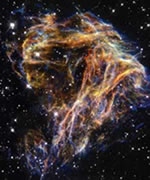
Image credit: Hubble
The most recent image taken by the Hubble Space Telescope shows the delicate looking remnants from a supernova explosion in our nearest galaxy. The remnant, called LMC N 49, is located in the Large Magellanic Cloud, and the supernova would have been visible several thousand years ago. At the core of the object is a rapidly-spinning neutron star which has a magnetic field a quadrillion times stronger than the Earth’s field; objects like this are called magnetars.
Resembling the puffs of smoke and sparks from a summer fireworks display in this image from NASA’s Hubble Space Telescope, these delicate filaments are actually sheets of debris from a stellar explosion in a neighboring galaxy. Hubble’s target was a supernova remnant within the Large Magellanic Cloud (LMC), a nearby, small companion galaxy to the Milky Way visible from the southern hemisphere.
Denoted N 49, or DEM L 190, this remnant is from a massive star that died in a supernova blast whose light would have reached Earth thousands of years ago. This filamentary material will eventually be recycled into building new generations of stars in the LMC. Our own Sun and planets are constructed from similar debris of supernovae that exploded in the Milky Way billions of years ago.
This seemingly gentle structure also harbors a very powerful spinning neutron star that may be the central remnant from the initial blast. It is quite common for the core of an exploded supernova star to become a spinning neutron star (also called a pulsar – because of the regular pulses of energy from the rotational spin) after the immediate shedding of the star’s outer layers. In the case of N 49, not only is the neutron star spinning at a rate of once every 8 seconds, it also has a super-strong magnetic field a thousand trillion times stronger than Earth’s magnetic field. This places this star into the exclusive class of objects called “magnetars.”
On March 5, 1979, this neutron star displayed a historic gamma-ray burst episode that was detected by numerous Earth-orbiting satellites. Gamma rays have a million or more times the energy of visible light photons. The Earth’s atmosphere protects us by blocking gamma rays that originate from outer space. The neutron star in N 49 has had several subsequent gamma-ray emissions, and is now recognized as a “soft gamma-ray repeater.” These objects are a peculiar class of stars producing gamma rays that are less energetic than those emitted by most gamma-ray bursters.
The neutron star in N 49 is also emitting X-rays, whose energies are slightly less than that of soft gamma rays. High-resolution X-ray satellites have resolved a point source near the center of N 49, the likely X-ray counterpart of the soft gamma-ray repeater. Diffuse filaments and knots throughout the supernova remnant are also visible in X-ray. The filamentary features visible in the optical image represent the blast wave sweeping through the ambient interstellar medium and nearby dense molecular clouds.
Today, N 49 is the target of investigations led by Hubble astronomers You-Hua Chu from the University of Illinois at Urbana-Champaign and Rosa Williams from the University of Massachusetts. Members of this science team are interested in understanding whether small cloudlets in the interstellar medium of the LMC may have a marked effect on the physical structure and evolution of this supernova remnant.
The Hubble Heritage image of N 49 is a color representation of data taken in July 2000, with Hubble’s Wide Field Planetary Camera 2. Color filters were used to sample light emitted by sulfur ([S II]), oxygen ([O III]), and hydrogen (H-alpha). The color image has been superimposed on a black-and-white image of stars in the same field also taken with Hubble.
Original Source: Hubble News Release
Another Delay for Opportunity
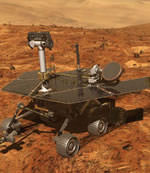
Image credit: NASA
NASA has pushed back the launch of its second Mars Exploration rover, “Opportunity”, again; this time because of a battery failure on the Boeing Delta II booster. The launch has now been set for Tuesday, July 8 at 0235 GMT (10:35 pm EDT Monday). Even this launch date is at risk, though, as there’s a 30% chance of weather problems. It looks like the previous problem with the booster’s cork insulation has been resolved; although, engineers will be performing further tests to ensure that everything’s fine. The spacecraft must launch before July 15 in order to reach Mars.
The launch of the MER-B Mars Exploration Rover ?Opportunity? aboard a Boeing Delta II rocket has been postponed an additional 24 hours. The delay is due to the failure of a battery cell associated with a component of the launch vehicle?s flight termination system. The battery must be removed and replaced.
Launch is now targeted for no earlier than Monday, July 7. The two launch times available are 10:35:23 and 11:18:15 p.m. EDT. The forecast calls for a 30% chance of not meeting the launch weather criteria on Monday evening.
At Pad 17-B, a tanking test of the Delta rocket was conducted this morning. The first stage was loaded with cryogenic liquid oxygen to evaluate the bonding of the lower band of cork thermal insulation. This afternoon, NASA and Boeing managers met to discuss the outcome of the tanking test and other associated testing and engineering evaluations that have been conducted over the last several days.
After the tanking, inspections revealed some selective debonding of the cork from the surface of the vehicle within a limited area. These locations are being repaired using a different adhesive with a stronger bonding characteristic as demonstrated by tests conducted at KSC late this week. This work was completed tonight and the problem has been resolved to the satisfaction of engineers.
Original Source: NASA News Release
Mobile Edition of Universe Today
I’ve had a few requests for this, so I’m taking a stab at creating a mobile version of Universe Today. I always like to start this kind of thing small and build from there, so I’ve created a special page with a slimmed-down version of the homepage, with the first 5 stories.
But I need your help. If you have a mobile device, like a Blackberry, Palm Pilot, web-enabled phone, etc, can you do me a favour and take a look at the page? Here’s a link to it. This page will stay up to date with the home page. My page should look good, but the external links to other sites won’t fit so well.
My next question is to figure out a way to send this out to people, so I’m looking for some volunteers with various portable devices to let me experiment with various ways of delivering this to you. I was thinking of just adding another newsletter in a wireless format. Obviously this’ll be totally free as well.
If you want to take part, just drop me an email and I’ll coordinate with you.
Thanks!
Fraser Cain
Publisher
Universe Today
Japanese Space Shuttle Prototype Crashes
The prototype for a Japanese-built space shuttle crashed on landing Tuesday, breaking its left wing and nose cone. The 4-metre unmanned prototype was lifted by balloon in Sweden to an altitude of 21 kilometres and then plunged back to Earth, reaching 80% the speed of sound. Unfortunately, two of its three parachutes failed to open and it had a hard landing. Controllers got the aerodynamic data they needed, but the prototype is likely too damaged to be used again for future tests.
Similar Solar System Discovered
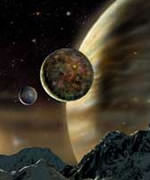
Image credit: PPARC
A team of international astronomers have discovered a planet which is remarkably similar to Jupiter. This new planet circles a star called HD70642 (in the constellation of Puppis) 90 light-years from Earth. It’s twice the mass of Jupiter and its orbit is nearly circular around HD70642 at a distance similar to Jupiter’s from our own Sun. Furthermore, there don’t seem to be any larger planets closer to the star. This planetary discovery is the most similar to our own solar system found so far.
Astronomers looking for planetary systems that resemble our own solar system have found the most similar formation so far. British astronomers, working with Australian and American colleagues, have discovered a planet like Jupiter in orbit round a nearby star that is very like our own Sun. Among the hundred found so far, this system is the one most similar to our Solar System. The planet’s orbit is like that of Jupiter in our own Solar System, especially as it is nearly circular and there are no bigger planets closer in to its star.
“This planet is going round in a nearly circular orbit three-fifths the size of our own Jupiter. This is the closest we have yet got to a real Solar System-like planet, and advances our search for systems that are even more like our own,” said UK team leader Hugh Jones of Liverpool John Moores University.
The planet was discovered using the 3.9-metre Anglo-Australian Telescope [AAT] in New South Wales, Australia. The discovery, which is part of a large search for solar systems that resemble our own, will be announced today (Thursday, July 3rd 2003) by Hugh Jones (Liverpool John Moores University) at a conference on “Extrasolar Planets: Today and Tomorrow” in Paris, France.
“It is the exquisite precision of our measurements that lets us search for these Jupiters – they are harder to find than the more exotic planets found so far. Perhaps most stars will be shown to have planets like our own Solar System”, said Dr Alan Penny, from the Rutherford Appleton Laboratory.
The new planet, which has a mass about twice that of Jupiter, circles its star (HD70642) about every six years. HD70642 can be found in the constellation Puppis and is about 90 light years away from Earth. The planet is 3.3 times further from its star as the Earth is from the Sun (about halfway between Mars and Jupiter if it were in our own system).
The long-term goal of this programme is the detection of true analogues to the Solar System: planetary systems with giant planets in long circular orbits and small rocky planets on shorter circular orbits. This discovery of a -Jupiter- like gas giant planet around a nearby star is a step toward this goal. The discovery of other such planets and planetary satellites within the next decade will help astronomers assess the Solar System’s place in the galaxy and whether planetary systems like our own are common or rare.
Prior to the discovery of extrasolar planets, planetary systems were generally predicted to be similar to the Solar System – giant planets orbiting beyond 4 Earth-Sun distances in circular orbits, and terrestrial mass planets in inner orbits. The danger of using theoretical ideas to extrapolate from just one example – our own Solar System – has been shown by the extrasolar planetary systems now known to exist which have very different properties. Planetary systems are much more diverse than ever imagined.
However these new planets have only been found around one-tenth of stars where they were looked for. It is possible that the harder-to-find very Solar System-like planets do exist around most stars.
The vast majority of the presently known extrasolar planets lie in elliptical orbits, which would preclude the existence of habitable terrestrial planets. Previously, the only gas giant found to orbit beyond 3 Earth-Sun distances in a near circular orbit was the outer planet of the 47 Ursa Majoris system – a system which also includes an inner gas giant at 2 Earth-Sun distances (unlike the Solar System). This discovery of a 3.3 Earth-Sun distance planet in a near circular orbit around a Sun-like star bears the closest likeness to our Solar System found to date and demonstrates our searches are precise enough to find Jupiter- like planets in Jupiter-like orbit.
To find evidence of planets, the astronomers use a high- precision technique developed by Paul Butler of the Carnegie Institute of Washington and Geoff Marcy of the University of California at Berkeley to measure how much a star “wobbles” in space as it is affected by a planet’s gravity. As an unseen planet orbits a distant star, the gravitational pull causes the star to move back and forth in space. That wobble can be detected by the ‘Doppler shifting’ it causes in the star’s light. This discovery demonstrates that the long term precision of the team’s technique is 3 metres per second (7mph) making the Anglo-Australian Planet Search at least as precise as any of the many planet search projects underway.
Original Source: PPARC News Release
Opportunity Launch Delayed Again
The launch of NASA’s second Mars Exploration rover, Opportunity, has been delayed again to Monday, July 7 as early as 0243 GMT (10:43 pm EDT Sunday). The delay will give technicians time to ensure that the booster’s cork insulation is properly adhered. If all goes well, Opportunity will blast off from the Kennedy Space Center in Florida on board a Delta 2 rocket and follow its partner spacecraft, Spirit, already en route to the Red Planet. Launch windows for the spacecraft are available until July 15.
Partial Fix for SOHO
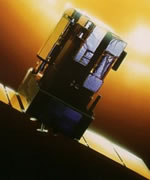
Image credit: ESA
After performing several tests on the troubled SOHO spacecraft, engineers believe they have a solution to ensure that the spacecraft doesn’t have any blackout periods. The pointing mechanism on SOHO’s high-gain antenna malfunctioned on June 27, 2003. Controllers have figured out a way to use larger ground-based receivers which can receive data from the low-gain antenna for a longer period, and receive all the data that SOHO needs to send. Engineers will continue to fix the problem with the high-gain antenna’s motor.
After a number of tests and new insights, SOHO engineers now say there will be no ‘blackout’ periods for SOHO science data.
High-rate transmissions from the Solar and Heliospheric Observatory (SOHO) were initially interrupted on 27 June 2003. The interruption was expected due to a recent malfunction in the pointing mechanism of the spacecraft’s high-gain antenna (HGA). The loss of signal occurred on a 26-metre station of NASA?s Deep Space Network (DSN).
Until 30 June 2003, however, the spacecraft continued beaming down its science data, which were successfully picked up by larger 34-metre DSN stations (when available). In addition, dumping on-board recorder data during these contacts has further reduced data losses so far.
On 30 June 2003, the 70-metre DSN station in Madrid, Spain, successfully received high-rate science data through SOHO’s omnidirectional on-board low-gain antenna. SOHO normally uses this antenna only for low-rate telemetry in emergencies, and the antenna does not need to be repointed.
Successful switch
Even better, when high-rate telemetry was lost on 1 July 2003, during a 34-metre station pass, engineers successfully switched SOHO into a medium-rate telemetry mode, using the low-gain antenna. In medium rate, all real-time science telemetry can be downlinked during station passes. However, on-board recorder dumps are not possible in this mode.
The relatively late occurrence of the initial loss of contact means that the effective SOHO’s HGA antenna beam width is larger than anticipated. Also, since the 34-metre stations are much quieter than the smaller stations, you can use them for longer time periods than expected. Being able to transmit science data through the on-board low-gain antenna using 70- and 34-metre stations therefore means that there will be no hard blackout periods for SOHO science data, given sufficient ground station resources.
Minor losses
However, 34- and 70-metre stations are in higher demand than the 26-metre stations that SOHO normally relies on. Some data losses are therefore expected every day during the 2-3 week periods. “We’re now talking only moderate fractions per day every day during the 2-3 week periods,” says Bernhard Fleck, ESA?s SOHO Project Scientist.
SOHO scientists expect full high-rate telemetry coverage, even on 26-metre stations, to resume on or about 14 July 2003. To achieve this, they will make the spacecraft roll 180? around its Sun-pointing axis in a manoeuvre currently planned for 8 July 2003.
Original Source: ESA News Release
Space and Astronomy Books for July, 2003
It’s July already, time to organize your summer reading. Universe Today has a list of all the space and astronomy books scheduled for publication in July, 2003. I’ve provided a list of all the books, as well as the Author and a brief description from the publisher. I’ve also got links where you can buy them in the US, UK and Canada. If there’s something that interests you, just pre-order it and you’ll get it days after release. If I get any review copies, I’ll provide additional links to my reviews.
Of course, you can also put in reservations at your local library and beat the crowds. 🙂
| Image | Title | Author | Description | Amazon US | Amazon UK | Amazon Canada |
| To the End of the Solar System: The Story of the Nuclear Rocket | James A. Dewar | Chemically propelled rockets can lift less than 5 percent of their take-off weight into orbit, a fact that could forever limit the space program. Nuclear-powered rockets, however, with their superior thrusting power and speed, are radically different. So argues James A. Dewar in the only comprehensive history ever written of the nuclear rocket project. | US | UK | CAN | |
| ***image6*** | The Future of Theoretical Physics and Cosmology | Based on lectures given in honor of Stephen Hawking’s 60th birthday, this book comprises contributions from the world’s leading theoretical physicists. Popular lectures progress to a critical evaluation of more advanced subjects in modern cosmology and theoretical physics. | US | UK | CAN | |
| ***image8*** | Perilous Planet Earth: Catastrophes and Catastrophism through the Ages | Trevor Palmer | Reviewing our present concerns about the threat from natural disasters, such as asteroids and immense volcanic eruptions, within the context of history, this volume is written at a level that interests academics as well as general readers. | US | UK | CAN |
| ***image9*** | Seeing in the Dark: How Amateur Astronomers Are Discovering the Wonders of the Universe | Timothy Ferris | Paperback Edition | US | UK | CAN |
| Astronomy: A Beginner’s Guide to the Universe | Eric Chaisson, Steve McMillan | Like its best-selling predecessor, Astronomy Today (1993), this text presents scientific literacy in the context of astronomy, teaching students to think critically and analytically about the physical world and the development of science. | US | UK | CAN | |
| ***image7*** | Galileo’s Mistake: A New Look at the Epic Confrontation between Galileo and the Church | Wade Rowland, Allen Thomas | US | N/A | N/A | |
| ***image10*** | Star Watch: The Amateur Astronomer’s Guide to Finding, Observing, and Learning About over 125 Celestial Objects | Philip S. Harrington | The night sky is alive with many wonders??distant planets, vast star clusters, glowing nebulae, and expansive galaxies, all waiting to be explored. Let respected astronomy writer Philip Harrington introduce you to the universe in Star Watch, a complete beginner?s guide to locating, observing, and understanding these celestial objects. | US | UK | CAN |
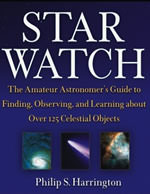
|
Dictionary of Minor Planet Names | Lutz D. Schmadel | US | UK | CAN | |

|
Firefly Atlas of the Universe | Patrick Moore | The Firefly Guide to the Universe is an encyclopedic examination of the stars, planets, and universe with the latest, most comprehensive information currently available. The book features the latest images from the Hubble Space Telescope which are put into context with clear and detailed text. | US | UK | CAN |
| ***image11*** | Traveler’s Guide to Mars: The Mysterious Landscapes of the Red Planet | William K. Hartmann | Paperback Edition | US | UK | CAN |
| Cataclysmic Variable Stars | Brian Warner | Cataclysmic variables are interacting binary stars that contain a white dwarf accreting from an orbiting companion. The study of these stars is currently undergoing an exciting renaissance as it embraces observations at all wavelengths. | US | UK | CAN | |

|
It Came from Outer Space: Everyday Products and Ideas from the Space Program | Marjolijn Bijlefeld, Robert L. Burke | What do anthrax protection, golf clubs, and cordless power tools have in common? Each was invented or improved with technology first developed for the space program. This book tells the story of 67 of the most consumer-friendly products born of space-related research. | US | UK | CAN |

|
Coming of Age in the Milky Way | Timothy Ferris | Paperback Edition | US | UK | CAN |
Mars Express Power Problems
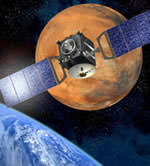
Image credit: ESA
Operators with the European Space Agency are currently testing various systems on the Mars Express spacecraft, and it looks like there’s a bit of a problem. It seems that there’s a connection problem between the spacecraft’s solar panels and its power conditioning system. If they can’t fix this problem, the spacecraft will only be able to operate at 70% power; however, it will still be able to perform nearly all of its objectives for the mission. Ground engineers will begin tests on the Beagle 2 lander on July 4.
ESA?s Mars Express spacecraft is progressing further every day on its journey to the Red Planet. Everything is set for arrival at Mars on the night of 25 December 2003, after a journey of about 400 million kilometres. In the weeks since its launch, engineers have started to thoroughly test the spacecraft and its equipment.
This testing phase is standard for all spacecraft on the way to their destination. Known as commissioning, it began 3 weeks after the launch. During this time, ground controllers sent signals to each of the orbiter’s seven instruments to switch them on and verify their health status.
As well as commissioning the instruments, the ground controllers also tested each of the spacecraft?s subsystems. There was a thrilling moment when one of the on-board computer memory units, known as the Solid State Mass Memory (SSMM), seemed to not respond properly during the instruments check-out. Good progress has been made on this issue in the last few days: a test involving all instruments was completed successfully by recording and recovering the data through the SSMM.
Unfortunately, during the commissioning of the power subsystem, ground engineers recorded an interconnection problem between the solar arrays and the power conditioning unit on board the spacecraft. This means approximately 70% of the power generated by the solar arrays is available for the satellite and its payload to use. This anomaly has no effect on the state of the spacecraft and has no impact on the mission during the whole trip to Mars, including the orbit insertion phase once at destination.
Despite this, the experts analysing the anomaly believe that even with this power shortage, the nominal Mars observation mission will be achievable. However, satellite payload operations may have to be reviewed for certain short periods of the mission.
Ground engineers are now preparing for the last of the payload?s tests: the Beagle-2 lander will undergo its check-out on 4-5 July 2003. The experts are looking confidently to it. “In fact,” says Rudolf Schmidt, Mars Express Project Manager, “overall, the spacecraft is in good shape. We are simply getting to know its personality.”
Original Source: ESA News Release
